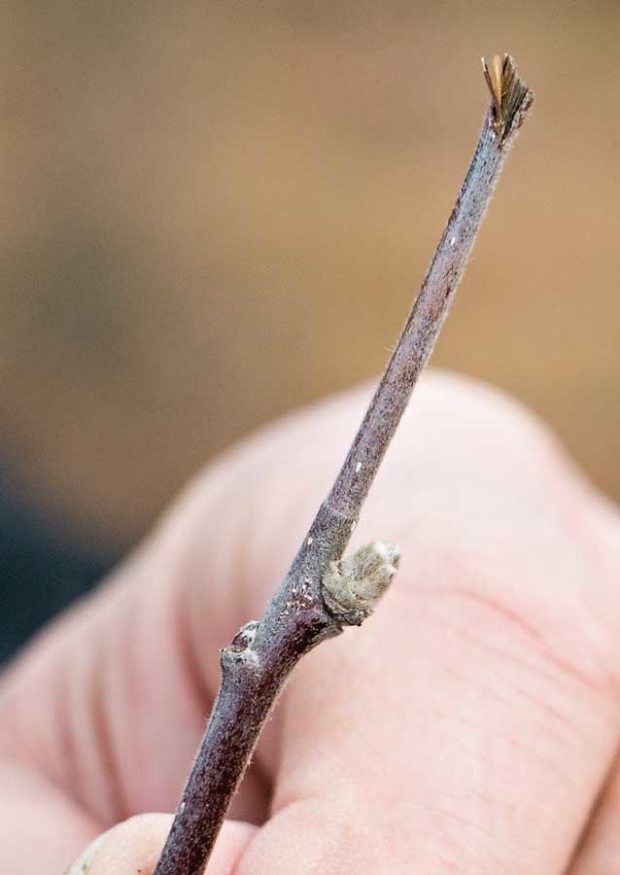While not exactly new anywhere, mechanical hedging is seeing a youthful surge on both sides of the U.S. as a way for fruit growers to improve fruit quality and produce a more consistent product.
Indeed, hedgers also reduce labor costs, but more importantly, they may improve canopy management, boost yields and help growers produce better fruit, not cheaper fruit, said Karen Lewis, a Washington State University regional extension specialist in Moses Lake, Washington.
“You do not buy this piece of equipment to save time and money,” she said. “You purchase this machine to put into your toolbox for crop load management and canopy management.”
Mechanical hedging uses motorized cutting arms mounted to tractors to shave trees into flat planes, making orchard rows more adaptable to harvesting platforms and other tools, improving worker efficiency and more evenly exposing fruit to sunlight, chemical coverage and evaporative cooling.
Trials

A grower checks out a mechanically hedged apple block in early February at the Michigan State University Clarksville Research Station during a tour at the International Fruit Tree Association’s annual convention. (Ross Courtney/Good Fruit Grower)
Researchers, for their part, have trials in all U.S. growing areas to study timing and techniques. And though Western growers typically lead the way in high volume innovation, Eastern growers have a head start in hedging. Lewis first saw a hedger in action during a European educational tour and learned that
 New York growers and researchers had been experimenting.
New York growers and researchers had been experimenting.
“You know in Washington, sometimes we are late,” she told growers at February’s International Fruit Tree Association convention in Grand Rapids, Michigan.
In fact, hedging was one of the major topics at the 2016 convention meetings and educational tours, coming up at nearly every stop. Speakers showed pictures of perfectly straight rows with harvesting platforms creeping their way through alleys within inches of the branches.
Hedgers have been around for decades, commonly used in grapes. As labor becomes scarcer and more expensive, tree fruit growers have looked for ways to mechanize that not only reduce the need for workers but also make tasks simpler with fewer rules and decisions.
A hedger makes a systematic approach simpler, using blades to shape an orchard canopy into a narrow “box,” moving from three-dimensional trees to a two-dimensional wall, Mario Miranda Sazo, a Cornell University extension specialist in Newark, New York, said during his conference presentation.
Sazo began trials in 2011, hedging tall spindle trees back to 18 to 20 inches during dormancy and 22 to 26 inches in the summer. The canopy ended up about as wide as the herbicide strip around the trunks.

A grower holds an apple branch showing how a bud shoot and growth shoot have emerged behind a rough, mechanical hedger cut in a Michigan State University Clarksville Research Station experimental block on Sunday, Feb. 7, 2016, during the a tour as part of the International Fruit Tree Association annual convention. (Ross Courtney/Good Fruit Grower)
Rod Farrow, a New York grower and one of Sazo’s collaborators, instructed conference attendees who are planting to keep their canopies narrow to maximize sun exposure and make way for mechanized tools such as hedgers as their trees age.
Don’t go beyond 3 feet, he warned. “Anything you plant, if you’re thinking beyond 3 feet, it’s obsolete, in my opinion,” said Farrow, an association board member generally regarded as an early adopter of technology and high efficiency systems.
At Michigan State University, Phil Schwallier, district horticulture educator, began hedging trials in 2014 and spent the first two years demonstrating and practicing on a block of seven different varieties, most of the trees on Nic 29 rootstock, at different times of the year at the Clarksville Research Center. The tall spindle trees are 10 years old and had never been hedged.
“That’s all we have to work with,” he said in an interview after the conference.
Hedging is easiest when trees are trained from planting to accommodate hedgers, but the mature block will give him and his colleagues information about how to transition from hand pruning to hedging.
He will begin quantifying results this year and expects to see the best increase in good return bloom from bloom-time hedging and June hedging, some return bloom from a July hedging and no impact from August or postharvest hedging, he said.
“Next year we’re going to really look at return bloom, return production, return fruit set,” he said.
So far, he has found that sunburn protection is more effective when applied after hedging than before.
Out in Washington, Lewis and her WSU collaborators, Dr. Matt Whiting and Dr. Stefano Musacchi, are conducting trials with hedgers in apples, pears and sweet cherries.
Overall, Lewis determined the hedger combined with some hand pruning is between 40 percent and 70 percent faster in apples than with hand labor alone.
“The machine wins every time,” she told the IFTA crowd.
Her research and demonstrations will continue throughout the 2016 growing season for the third and final year of her grant from the Washington State Tree Fruit Research Commission.

Limbs fly as the teeth of a mechanical hedger tears through a cherry block during a demonstration by WSU researcher Matt Whiting. (TJ Mullinax/Good Fruit Grower)
Grower perspective
Some growers really liked the results.
Columbia Fruit Packers’ Quincy and Ephrata orchards had 90 percent return bloom in their apples when they worked with Lewis and found the hedger made the work simpler for employees, said manager Ramon Gutierrez. He also liked the cost savings in labor.
“Running the hedger is so cheap,” he said.
Leonard Ligon, a Traverse City, Michigan, grower uses a hedger to keep permanent limbs from taking over his tree in favor of fresh growth.
“The days of farming apple trees with permanent wood are over,” he said. “That’s over. It’s obsolete.”
Hedgers range in price from, say, $15,000-$25,000 and are available from several American manufacturers.
Options include rotary or sickle bars with single or double arms and front or rear mounts. Some can be turned sideways for horizontal hedging, while others only work vertically. Sazo and Lewis work only with single row sickle bar hedgers in their trials.
The other perspective
Hedgers have drawbacks, of course.
For one, in Washington, hedgers can expose more fruit to sunburn if used too late in the summer. Meanwhile, hedger blades cause a whipping action that knocks apples off trees when used during fruit growth stages in mid-summer and sometimes damage limbs instead of cutting them clean.

Above, an ideal mechanically cut limb will look similar to a hand pruner, however, some non-ideal cuts do occur, showing frayed or mashed tips as seen at bottom. Non-ideal cuts sometimes are caused because a limb may be growing at an off angle or does not properly align with the trimming surfaces. (TJ Mullinax/Good Fruit Grower)
Lewis also found the hedger blades harmed some fruit, but the farm managers she worked with put the damage estimate at about 5 percent, which they found acceptable and simple enough for a thinning crew to remove.
In fact, hedgers don’t completely replace hand pruning. Most growers who use them said they send hand crews to clean up damaged wood and remove thicker, undesired limbs by hand.
Lewis recommends establishing a structural architecture with loppers during dormancy to prune trees for desired crop load and prepare the tree for the hedger to later remove only the wood growers want to remove. They may have to repeat that every one or two years.
“The mechanical hedger can remove the right wood and right amount of wood if the trees are set up,” she said in a follow-up interview. “Limb removal is a job for loppers.”
Mechanical hedging, like loppers, also can spread fire blight. Lewis suggested growers not use hedgers during an infection period if the bacteria is in the block.
In northwest Michigan, Farrow advised one grower against hedging a block of SweeTangos because doing so would reduce the canopy size even further and potentially lower the yield.
The trees on Bud 9 rootstocks in sandy soil at 4-by-12-foot spacing lacked enough vigor to provide adequate regrowth to refill, let alone increase, the canopy volume.
“Hedging isn’t for every system,” Farrow told him. •
– by Ross Courtney
Hedging trials
Washington State University researchers are in the third and final year of mechanical hedging trials in apple, pear and cherry orchards to compare timings and techniques, as well as demonstrate the machinery for growers.
Here are some of the details of the experiments and results so far.
—Karen Lewis, a Washington State University regional extension specialist, conducted the apple trials. Fuji apples on a Nic 29 roostock planted in 2009 and trained to slender spindle. The Masilin strain of Cripps Pink apple trials were on Malling 9.337 rootstock on spindle trees planted in 2012. All apple blocks were already established.
Among the results after two years:
—In Fujis, hedging was 40 percent to 70 percent faster than hand pruning. Hedging also reduced shoot growth without reducing return bloom or fruit quality.
—In both varieties, hedging pushed fruit and vegetative buds in blind wood near the trunk.
—In both varieties, Lewis found no negative impacts on fruit quality from mechanical pruning compared to pruning by hand or a combination of the two.—Dr. Stefano Musacchi conducted the pear trials in Bartlett pears on OHF87 rootstocks trained to spindle and planted in 2012 in Monitor, Washington. The block was set up specifically for hedging.
Among the results after only one year:
—A combination of mechanical hedging and hand pruning produced a greater proportion of large fruit, more than 70 millimeters in diameter, than hand pruning alone, and a smaller proportion of small fruit less than 55 millimeters in diameter.— Dr. Matt Whiting led the cherry trials, which featured Tieton cherries on Gisela 5 rootstocks trained to UFO and planted in 2008 and already established.
Among the results after two years:
—Mechanical hedging was 29 times faster than hand pruning alone and 17 times faster than a combination of the two.






Leave A Comment